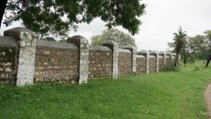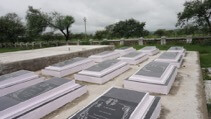Promoting cemetery conservation is a key BACSA aim. We make positive interventions where there is a strong local base of people willing to restore cemeteries: church leaders; a cemetery committee; a church congregation; the local chapter of the Indian National Trust for Art and Cultural Heritage (INTACH) in the case of India; a group of like-minded people wishing to conserve local heritage. BACSA provides financial aid and advice. We do not supervise restoration work but encourage the impetus from local communities so that they maintain a vested interest. BACSA’s priorities are to improve cemetery security by restoring cemetery walls and gatehouses; to remove obtrusive plants from graves; to record surviving inscriptions and burial registers where they exist, and to restore tombs sensitively and in accordance with approved conservation practice.
Read our Projects Report 2024, (page 7 of Annual Report) or learn about some recent projects in more detail below.
BACSA relies on its local partners to send photographs demonstrating the work required and obtain builders’ estimates. Where BACSA approves a project proposal and makes a grant, the partner supervises the work and provides a report and photographs to show what has been achieved. We are conscious of the need to see that its money is well spent. We assess conservation proposals carefully and do our best to ensure that our grants go to trustworthy partners for practicable cost-effective projects.
Examples of conservation projects
A crucial first task in cemetery conservation is to secure the site, and BACSA has made several grants for work of this kind. For example, at the Haigh Road Cemetery in Saugar, Madhya Pradesh, India, a grant contributed to repairing the boundary wall and gate in 2018.
Anderson Monument, St Mary’s Cemetery, Chennai
An important conservation achievement of our major project at St Mary’s Cemetery on the Island in Chennai (Madras) has been the rescue of the monument to Dr James Anderson. He was Scottish physician and botanist who became Surgeon-General in Madras in 1781. He set up a botanical garden in Madras and introduced mulberry trees. He died in 1809 at the age of 72. His impressive grave had been invaded by trees which had grown between the brick masonry and stone cladding, displacing the built structure. The steps up to it had been made inaccessible, the floor tilted and the black, Latin-inscribed grave stone cracked.
Under the guidance of our Area Representative, Ravindra Gundu Rao, who is also a conservation architect, and our expert contractors we concluded that removing all the vegetation would destroy the monument. It was cut back and set back as much as possible. The structure was then consolidated and repaired with traditional materials, such as lime mortar, laterite bricks and stones of similar nature and colour. A flat piece of glass and lead filling were added to the top to prevent water ingress. The rescued monument has been given a new lease of life, but will need expert maintenance to keep the vegetation under control.
Lovedale Cemetery at the Lawrence School
Our partnership with the Lawrencian Association to conserve the Lawrence School Cemetery in Nilgiris, India, is a powerful example of what BACSA can achieve when we have an enthusiastic and motivated partner who is able to enthuse the local community.
Hyderabad Residency Cemetery
The cemetery of the former British Residency in Hyderabad, India, was in a desolate condition until the Deccan Heritage Foundation joined BACSA in 2016 to conserve the graveyard. The cemetery, the restored former Residency and its garden form a significant addition to Hyderabad’s built heritage and have become an attractive destination for visitors from both India and abroad.
Nicholson Cemetery, Delhi
BACSA’s project to conserve Delhi’s Nicholson or ‘Cashmere’ Cemetery is another example of cooperation. The Delhi Chapter of the Indian National Trust for Art and Cultural Heritage is BACSA’s local conservation partner. The estimated project costs are beyond BACSA’s resources; funding from Indian and British sources will be needed if the project is to succeed.
William Coates Blaquiers Tomb
In Calcutta in 2018, BACSA funded the conservation of six ‘heritage’ tombs in the Lower Circular Road Cemetery, in cooperation with the Christian Burial Board. One tomb is that of William Coates Blaquiers, the early 19th century head of Calcutta’s police force and founder of its detective department.



